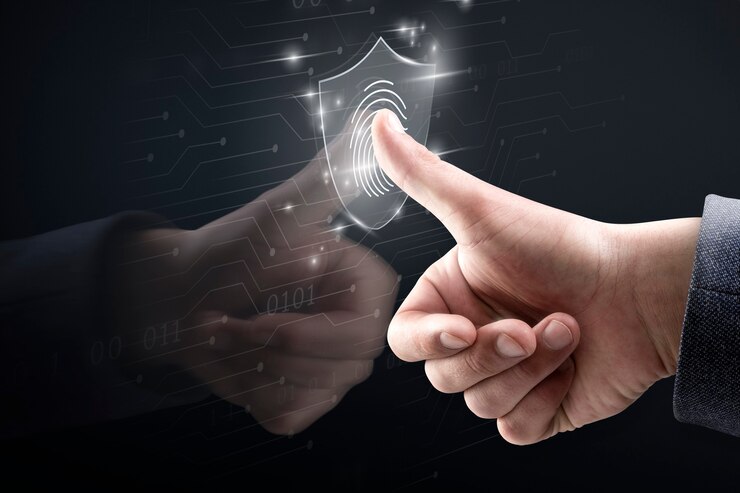Biometric technology encompasses various methods of identifying individuals, while fingerprint recognition specifically relies on identifying individuals through their unique fingerprints. Biometric technology includes fingerprint recognition as one method of identification but also encompasses other methods such as facial recognition and iris scanning.
Within the realm of biometric technology, fingerprint recognition specifically focuses on the unique patterns found on an individual’s fingertips to verify their identity. Both biometrics and fingerprint recognition aim to provide secure and accurate identification, but fingerprint recognition concentrates solely on using the unique patterns of an individual’s fingertips for this purpose.
As technology continues to advance, both biometrics and fingerprint recognition are increasingly being utilized for various applications ranging from security systems to mobile devices.

Understanding Biometric Technology
Definition Of Biometric Technology
Biometric technology involves analyzing and measuring unique biological or behavioral characteristics for authentication and identification purposes. Unlike traditional methods such as passwords or PINs, biometric technology uses physiological and behavioral attributes that are difficult to duplicate, thus providing a higher level of security.
Types Of Biometric Authentication
Biometric authentication uses various characteristics for identification, including fingerprints, iris patterns, facial recognition, voiceprints, and more. Each of these types of biometric authentication has its own unique method of capturing and analyzing data, ensuring accurate verification of an individual’s identity.
Applications Of Biometric Technology
In today’s digital world, biometric technology finds applications across diverse sectors such as security, access control, time and attendance tracking, identity verification, and mobile device authentication. This technology has enhanced security measures in governmental agencies, healthcare institutions, banking and finance, and is also widely used in consumer devices such as smartphones and tablets.
Understanding Fingerprint Technology
Fingerprint technology is a type of biometric identification that uses unique physical characteristics of an individual’s fingerprints to grant access or verify identity. It is a commonly used method in various applications such as smartphones, access control systems, and law enforcement. Understanding how fingerprint technology works and its advantages and limitations can provide valuable insights into its practical use and potential limitations.
Definition Of Fingerprint Technology
Fingerprint technology, also known as fingerprint recognition, is a biometric identification method that uses an individual’s unique fingerprint patterns for authentication and identification purposes. It relies on capturing and analyzing the distinct ridges, valleys, and minutiae points present in an individual’s fingerprints to create a unique and secure identity template.
How Fingerprint Recognition Works
Fingerprint recognition works by capturing an individual’s fingerprint image using a sensor, which is then processed to extract the unique fingerprint features such as ridge endings, bifurcations, and other characteristics. The extracted features are converted into a mathematical template, which is then stored for comparison with future fingerprint scans. When an individual attempts to authenticate using fingerprint recognition, their fingerprint scan is compared with the stored template to verify their identity.
Advantages And Limitations Of Fingerprint Technology
Fingerprint technology offers several advantages, including high accuracy, convenience, and non-repudiation, as fingerprints are unique to each individual. However, it also has limitations such as susceptibility to spoofing, potential privacy concerns, and the need for high-quality fingerprint scans for reliable recognition.
Difference Between Biometric And Fingerprint
When it comes to safeguarding sensitive information and enhancing security measures, biometric and fingerprint technologies play a pivotal role. While both are integral components of modern authentication and identification systems, they possess distinct features and uses.
Biometric Technology: Features And Uses
Biometric technology utilizes unique physical or behavioral characteristics, such as fingerprints, iris patterns, facial features, and voice recognition, to verify and authenticate an individual’s identity. It offers a seamless and secure means of access control, time tracking, and identity verification in various applications, including government agencies, financial institutions, and corporate organizations.
Fingerprint Technology: Features And Uses
Fingerprint technology specifically revolves around the identification and verification of individuals based on their unique fingerprint patterns. It offers a highly reliable and efficient method for personal authentication and access control, commonly found in smartphones, laptops, and physical security systems.
Comparative Analysis Of Biometric And Fingerprint Technology
| Aspect | Biometric Technology | Fingerprint Technology |
|---|---|---|
| Identification Method | Utilizes various physical and behavioral characteristics for identification. | Dependent solely on fingerprint patterns for identification. |
| Applications | Widely used in government security, time attendance, and financial sectors. | Predominantly integrated into consumer devices, physical access control systems, and law enforcement. |
| Accuracy | Offers high accuracy due to the utilization of multiple biometric modalities. | Provides reliable and precise identification based on fingerprint patterns. |
| Integration | Compatible with various systems and software for seamless integration. | Easily integrated into a wide array of consumer and security devices. |
| Adoption | Witnessing widespread adoption across diverse industries and sectors. | Already extensively adopted in consumer electronics and security applications. |

Credit: www.biometricupdate.com
Security And Privacy Considerations
In today’s digital age, security and privacy considerations are critical when it comes to the use of biometric and fingerprint technologies. Both methods offer unique ways to authenticate and verify individuals, but there are important distinctions to be made in terms of the security and privacy implications. Understanding the differences in biometric data security, fingerprint data security, and the legal and ethical implications of these technologies is essential for organizations and individuals utilizing them.
Biometric Data Security And Privacy Concerns
Biometric data, such as facial recognition or iris scans, raises significant security and privacy concerns. The storage and transmission of biometric information must be secure to prevent unauthorized access and misuse. Biometric data security requires robust encryption protocols and secure storage measures to safeguard individuals’ sensitive information. Moreover, privacy concerns arise due to the potential for misuse or unauthorized collection of biometric data, necessitating strict regulations and consent requirements.
Fingerprint Data Security And Privacy Concerns
Fingerprint data security involves protecting the unique biometric characteristics of individuals’ fingerprints. Like other biometric data, fingerprint information must be securely stored and transmitted to prevent unauthorized access and exploitation. Additionally, privacy concerns include the risk of identity theft through unauthorized access to fingerprint databases, highlighting the need for stringent security mechanisms and ethical handling of such data.
Legal And Ethical Implications Of Biometric And Fingerprint Technology
Leveraging biometric and fingerprint technology raises legal and ethical considerations that organizations and individuals must navigate. Legal frameworks around data protection and privacy, such as the General Data Protection Regulation (GDPR) and the California Consumer Privacy Act (CCPA), impose strict requirements for the collection, storage, and use of biometric and fingerprint data. Moreover, ethical implications pertain to the responsible and transparent use of these technologies, including the potential impact on individuals’ rights and freedoms.
Future Trends And Developments
In the world of biometric and fingerprint technology, the future holds a myriad of exciting trends and developments. From emerging innovations in biometric technology to advancements in fingerprint recognition, and the integration of biometric and fingerprint technology, the industry is on the precipice of significant transformation. Let’s explore what the future has in store for these cutting-edge technologies.
Emerging Innovations In Biometric Technology
The field of biometric technology is witnessing rapid advancements, with emerging innovations poised to revolutionize the industry. One of the most noteworthy developments is the integration of multi-modal biometrics, which combines various biometric identifiers such as facial recognition, iris scanning, and voice authentication to enhance accuracy and security. Moreover, advancements in behavioral biometrics, incorporating factors such as typing patterns and gait analysis, are paving the way for more sophisticated and nuanced identification methods.
Advancements In Fingerprint Recognition Technology
Fingerprint recognition technology is undergoing continuous refinement, with a focus on enhancing accuracy, speed, and versatility. The integration of 3D fingerprint imaging technology is a significant leap forward, enabling more precise and reliable authentication. Additionally, the development of contactless fingerprint recognition, utilizing advanced sensors and algorithms, is set to redefine the user experience and expand the applicability of fingerprint technology across various sectors.
Integration Of Biometric And Fingerprint Technology
An emerging trend in the biometric and fingerprint technology landscape is the seamless integration of these two modalities. This convergence has the potential to create synergistic solutions that leverage the strengths of both biometric and fingerprint technologies. By integrating biometric identifiers with fingerprint recognition, businesses and organizations can establish comprehensive and robust security systems that offer heightened levels of authentication and access control, while also streamlining user interactions and experiences.
Frequently Asked Questions For What Is The Difference Between Biometric And Fingerprint?
Is Biometric The Same As Fingerprinting?
Biometric refers to various types of identifying characteristics, while fingerprinting specifically involves capturing and analyzing fingerprints. Both are used for identity verification, but biometrics encompasses a broader range of methods.
What Are The 3 Types Of Biometric Examples?
The 3 types of biometric examples are fingerprint recognition, facial recognition, and iris recognition. These technologies use unique physical characteristics for identification.
Are Fingerprint Biometrics Accurate?
Yes, fingerprint biometrics are accurate due to the unique patterns of each person’s fingerprints. They have a very low error rate, making them a reliable method of identification and authentication.
Which Finger Is Used For Biometric?
The index finger is commonly used for biometric authentication due to its ease of use and reliability.
Conclusion
Biometric technology encompasses various methods, with fingerprint recognition being one of its most common applications. While both biometric and fingerprint technologies rely on unique physical characteristics for identification, biometric systems may incorporate additional features such as hand geometry and facial recognition.
Understanding the differences between these technologies is essential for implementing effective security measures.
